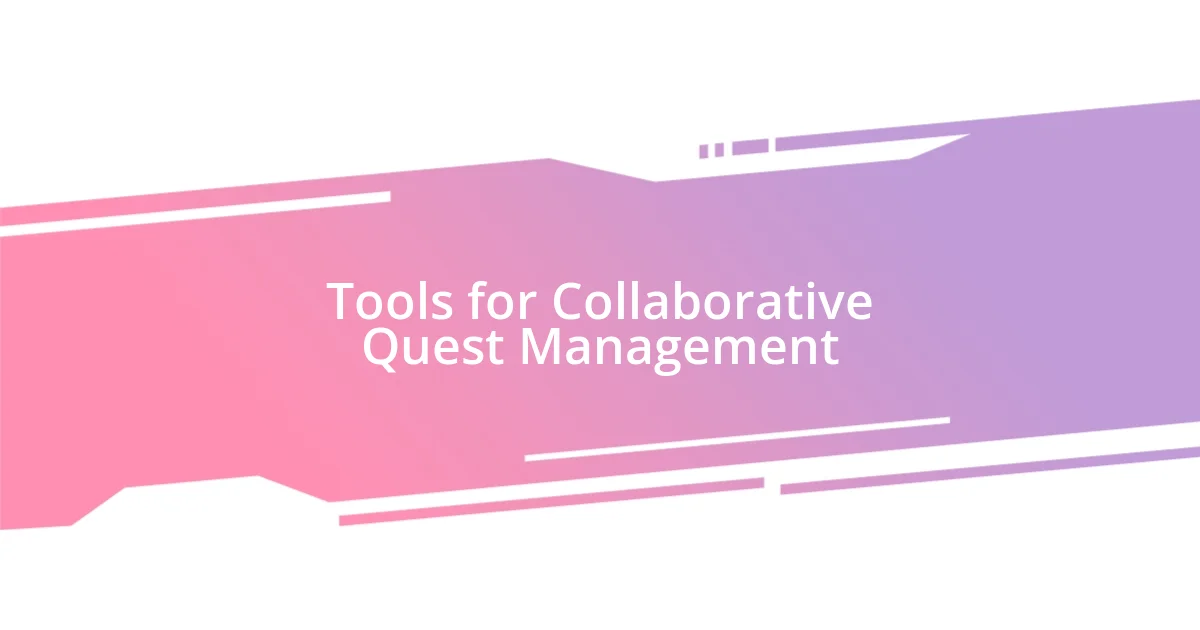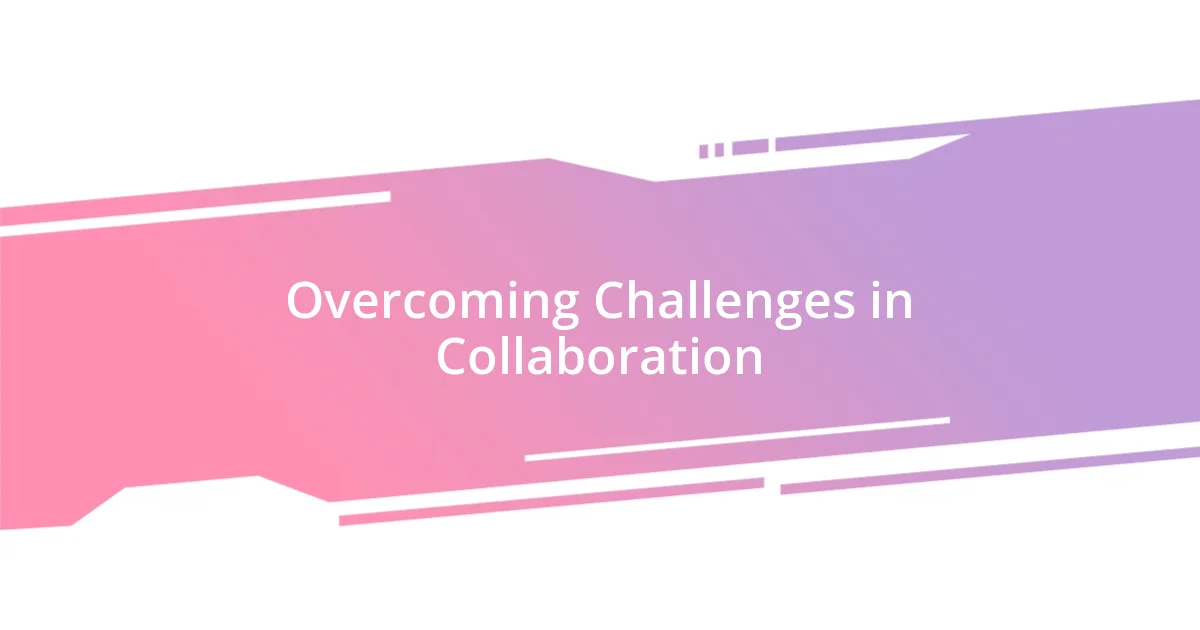Key takeaways:
- Effective collaboration in quests thrives on clear communication, trust, and a shared vision, enhancing problem-solving and team dynamics.
- Setting specific, flexible goals facilitates accountability and empowerment, ensuring team members are engaged and aligned.
- Overcoming challenges through empathy, open discussions, and adapting to different working styles fosters creativity and strengthens relationships within the team.

Understanding Collaboration in Quests
When I think about collaboration in quests, I often recall a time when my team and I were navigating a particularly challenging mission. We each brought our unique skills to the table, and it was fascinating how our diverse perspectives not only fueled our creativity but also strengthened our bonds. Isn’t it amazing how collaboration can turn a seemingly insurmountable challenge into a shared adventure?
In quests, effective collaboration hinges on clear communication and trust. I’ve found that sharing our thoughts early in the process cultivates an environment where everyone feels valued. This openness allows us to address obstacles collaboratively—encouraging us to brainstorm solutions together rather than feeling isolated. Have you ever noticed how this dynamic shifts the energy in the group, making the quest more enjoyable and fulfilling?
Another poignant experience was during a quest where we had to make quick decisions under pressure. I remember the adrenaline rush as we relied on each other’s insights and instincts. It struck me just how vital it is for team members to trust one another. When you know someone has your back, it becomes easier to take risks. Isn’t that the essence of collaboration—facing challenges together and celebrating victories as a unified team?

Benefits of Collaborative Quests
Engaging in collaborative quests brings a myriad of benefits that extend beyond the immediate objectives. One striking realization I had was how these quests can enhance interpersonal relationships. For instance, while tackling a complex puzzle together, we not only found solutions but also built a deeper understanding of each other’s strengths and weaknesses. That sense of camaraderie makes the challenges rewarding on a personal level.
The benefits of participating in collaborative quests can be summed up as follows:
- Enhanced problem-solving: Diverse perspectives lead to more innovative solutions.
- Stronger relationships: Shared experiences foster trust and connection among team members.
- Increased motivation: Working together creates a sense of accountability and encouragement.
- Skill sharing: Each member contributes unique expertise, broadening everyone’s skill set.
- Improved communication: Active collaboration necessitates open discussion, leading to better understanding.
I’ll never forget the time when we faced a particularly grueling obstacle, and instead of feeling frustrated, we rallied together, brainstorming ideas and really listening to each other. It felt less like a task and more like a shared mission. That unity didn’t just propel us forward; it left a lasting impression on each of us, reminding me of the profound impact that collaboration can have on our personal growth and team dynamics.

Setting Goals for Effective Collaboration
Setting goals is crucial when aiming for effective collaboration. From my perspective, clear and achievable goals create a shared vision that unites the team. I recall a quest where we defined our objectives upfront, laying out what success looked like. This clarity helped us stay focused and motivated, even when challenges arose. Have you ever felt lost in a project without clear goals? It’s a frustrating experience, but having a roadmap can make all the difference.
In my experience, specific goals also facilitate accountability among team members. For example, I remember a time when we divided tasks based on each individual’s strengths, ensuring that everyone had a defined role. This not only clarified expectations but also empowered each of us to take ownership of our contributions. I’ve found that when team members understand their responsibilities, they’re more likely to engage fully in the collaboration process.
Lastly, I believe it’s essential to keep these goals flexible. I learned during a recent quest that sometimes, as we delve deeper into the project, our objectives might need adjusting. Maintaining an open dialogue about our goals allowed us to adapt without losing our collaborative spirit. Embracing this adaptability helped us remain resilient, even when we faced unforeseen hurdles. It’s truly remarkable how setting the right goals can foster a more profound sense of teamwork and accomplishment.
| Goal Type | Description |
|---|---|
| Specific Goals | Clear objectives that provide direction for the team. |
| Measurable Goals | Defined metrics that allow tracking of progress. |
| Achievable Goals | Realistic objectives based on the team’s abilities. |
| Relevant Goals | Goals aligned with the overall mission of the quest. |
| Time-Bound Goals | Deadlines that create urgency and commitment. |

Tools for Collaborative Quest Management
Collaboration often requires the right tools to ensure everyone is aligned and engaged. I vividly recall using shared project management software during one of our quests. This platform not only helped us keep track of our tasks, but it also allowed us to communicate in real-time. Have you ever experienced the smooth flow of ideas when everyone can contribute simultaneously? It truly transformed our dynamics, making brainstorming sessions feel more like vibrant conversations rather than tedious meetings.
Another tool that proved invaluable was a shared digital space for resources and notes. I remember the excitement when we organized all our materials in one accessible location. We could revisit ideas and reflect on past discussions anytime we needed a spark of inspiration. This accessibility fostered a culture of continuous learning, and I found myself inspired by my teammates’ inputs more than I anticipated. It made me wonder, could the best ideas sometimes come from revisiting what we thought was already settled?
Additionally, incorporating video conferencing tools brought a personal touch to our virtual interactions. I experienced moments of profound connection while seeing each teammate’s expressions during discussions. These platforms ignited a sense of presence, allowing us to pick up on non-verbal cues. I often wonder if it’s possible to cultivate deeper connections just through the lens of a camera. In my experience, these tools helped bridge physical distances and made collaboration feel more intimate, contributing to our collective success in unexpected ways.

Communicating with Team Members
Effective communication is the backbone of any collaboration. I’ve found that regular check-ins with team members can transform the way we work together. In one of my quests, we implemented weekly catch-ups that became a safe space for sharing updates and addressing concerns. It was during one of these meetings that I realized how much I valued openly discussing challenges; it turned every potential roadblock into a stepping stone for growth.
In my experience, the tone and style of communication can greatly impact team dynamics. I remember a time when a more informal chat platform was introduced alongside our formal meetings. This shift created an environment where everyone felt comfortable sharing ideas, jokes, and even frustrations. It’s fascinating how a simple change, such as being able to send a quick message, can lead to deeper connections. Have you ever noticed how breaking down communication barriers can bring a group closer?
Listening is another crucial aspect that often gets overlooked. I learned this the hard way during a particularly heated discussion. I noticed that instead of engaging, some team members were tuning out. By actively encouraging everyone to share their thoughts, we turned the conversation around. I believe that fostering an inclusive dialogue not only enhances collaboration but also enriches the overall experience. Isn’t it amazing how a few simple changes in communication can elevate a team’s effectiveness?

Overcoming Challenges in Collaboration
Navigating challenges in collaboration can often feel like you’re facing a labyrinth. I recall a point in one of our quests when we hit a creative wall. Some team members were hesitant to speak up, fearing that their ideas might not be well-received. It struck me that fostering an environment of safety was essential. So, I initiated a “no bad ideas” brainstorming session, where we showered every thought with encouragement. That experience showed me how removing the fear of judgment can unleash a wave of creativity.
I’ve also encountered logistical hurdles during our collaborations. I remember a project where we were spread across different time zones, causing frustration and delays. One day, an idea popped into my mind: I suggested we map out everyone’s availability and create a shared online calendar. Surprisingly, this small adjustment allowed us to coordinate our efforts better, turning what felt like chaos into synchronized teamwork. Have you not noticed how simple solutions often lead to profound improvements?
At times, differences in working styles have posed challenges as well. I once worked with a particularly detail-oriented teammate, while I leaned towards a more big-picture perspective. Initially, this mismatch led to misunderstandings and tension. However, I took the initiative to schedule one-on-one sessions where we could clarify our preferences. This shift in perspective was enlightening; we discovered how our strengths complemented each other rather than clashed. It’s moments like these that remind me of the importance of empathy and understanding in collaboration. Isn’t it incredible how embracing differences can enhance our effectiveness?

Reflecting on Collaborative Experiences
Reflecting on collaborative experiences can be a journey filled with valuable lessons. During one project, I vividly remember a time when our differing perspectives sparked a healthy debate. I was surprised to find that instead of causing friction, this diversity of thought ignited a new level of creativity. Have you ever been in a situation where what seemed like a conflict turned into a breakthrough? It’s moments like these that remind me how essential it is to embrace various viewpoints.
Another memorable experience occurred while working closely with a teammate I initially found challenging. I was feeling overwhelmed by their analytical approach, which clashed with my instinctive style. Yet, as we began to share our approaches openly, I realized how much I could learn from their meticulousness. It reminded me that collaboration can often shine a light on strengths we might not recognize in ourselves. Have you noticed how sometimes the people who challenge us the most end up teaching us the greatest lessons?
One instance that stands out is when we faced an unexpected setback mid-project. Instead of panicking, the team rallied together to reassess and adapt our strategy. I felt a sense of camaraderie as everyone contributed ideas, and it dawned on me how collaboration brings out resilience. Isn’t it inspiring to witness how shared struggles can strengthen bonds within a team? Those are the experiences that truly highlight the beauty of working together toward a common goal.














